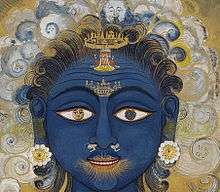Brahmaloka
Brahmaloka (Sanskrit: ब्रह्मालोक, IAST: Brahmāloka), is the abode of goddess Saraswati and Brahma, the creator god and part of a Trimurti along with Vishnu and Shiva in Hinduism. Located on Mount Meru, it is also referred to as Brahmapura, Satyaloka (satya meaning truth, loka meaning world, hence meaning true world), and/or Satya bagecha (bagecha means "garden") in the Puranas. Brahmaloka is a garden filled with all kinds of flowers.

It is stated that Brahmaloka is the highest of the joyful worlds a person might attain. However, Buddha adds that the Brahmaloka is impermanent. Brahmaloka is a big and beautiful garden made up of flowers.[1] Vedanta considers all spheres of existence, including the highest one namely Brahmaloka, to be temporary and only the absolute reality of infinite Pure Consciousness-Bliss is immortal and permanent.[2]
Brahmapura also called Satyaloka, is the topmost loka within this material universe. is the abode of Lord Brahma. It is also called Brahmaloka.
In Satyaloka, there are lotus flowers everywhere. These lotuses are huge, with divine energy flowing out of them. In the center of Brahmaloka, is Brahmapura. Brahmapura is a huge palace in which Brahma lives in. Below Satyaloka is Tapaloka and above it is the end of the material universe and the start of the Vaikuntha planets.[3]
Description
Brahmaloka is a planet composed entirely of Brahman, considered superior to svarga and is full of eternity, knowledge and bliss, the planet of the Bhagavān.[4]
The Second Canto (Bhagavatam 2.5.39) also equates Brahmaloka with the spiritual world,
mūrdhabhiḥ satya-lokas tu brahma-lokaḥ sanātanaḥ "Satyaloka, the topmost planetary system, is situated on the head of the form. The spiritual planet Brahmaloka, however, is eternal."
The statement shows Brahmaloka is an eternal Vaikuntha that is neither created nor within the material realm, and,
Brahman-lokah esa atma-lokah "Brahmaloka is the planet of the Supreme Soul."
The Chāndogya Upaniṣad says in 8:1[5]
"within the Brahmapura is an abode, a small lotus-flower within which is a small space (antarakasa). What is within that, should be searched out. That, assuredly, is what one should desire to understand."
Buddhism
In Buddhism, Brahmaloka refers to the highest celestial worlds, the abode of the Brahmas. It consists of twenty heavens:
- the nine ordinary Brahma-worlds,
- the Vehapphala.and
- the Asaññasatta
- the five Suddhāvāsā,
- the four Arūpa worlds,
All except the four Arūpa worlds are classed among the Rūpa worlds (the inhabitants of which are corporeal). The inhabitants of the Brahma worlds are free from sensual desires. The Brahma world is the only world devoid of women. Rebirth in the Brahma world is the result of great virtue accompanied by meditation. The Jataka tales contain numerous accounts of ascetics who practised meditation, being born after death in the Brahma world. When the rest of the world is destroyed at the end of a kappa, the Brahma world is saved and the first beings to be born on earth come from the ābhassara Brahma world. The Brahmās are represented as visiting the earth and taking an interest in the affairs of men. Thus, Nārada descends from the Brahma-world to dispel the heresies of King Angati in the Lord Brahma Nārada tale in the Mahanipata Jataka.
References
- K. Wagle, Narendra (1995). Society at the Time of the Buddha. Popular Prakashan. p. 97.
- https://www.gitasupersite.iitk.ac.in/srimad?language=dv&field_chapter_value=8&field_nsutra_value=16&etgb=1&choose=1
- "Satyaloka". Hindu Mythology Stories, Facts and Information. 2016-10-08. Retrieved 2020-01-10.
- Sri Brahma Samhita: with the commentary Dig-darsani-tika of Sri Jiva Gosvami. The Bhaktivedanta Book Trust.
- http://ishwar.com/hinduism/holy_upanishads/chhandogya_upanishad/part_08.html
Literature
- Self-Realization Brahmaanubhava: The Advaitic Perspective of Shankara: Brahmaanubhava: The Advaitic Perspective of Shankara (Cultural Heritage and Contemporary Change. Series Iiib, South Asia, V. 4) von Vensus A. George von Council for Research in Values & (Januar 2001) - page 103
- Sharma, Shubhra. Life In The Upanishads. Abhinav Publications; 1 edition (February 14, 2011)
- chhandogya upanishad as PDF
- Twitchell, Paul (1988) The Far Country. Illuminated Way Publishing. ISBN 0-914766-91-0
- Twitchell, The Far Country as PDF
